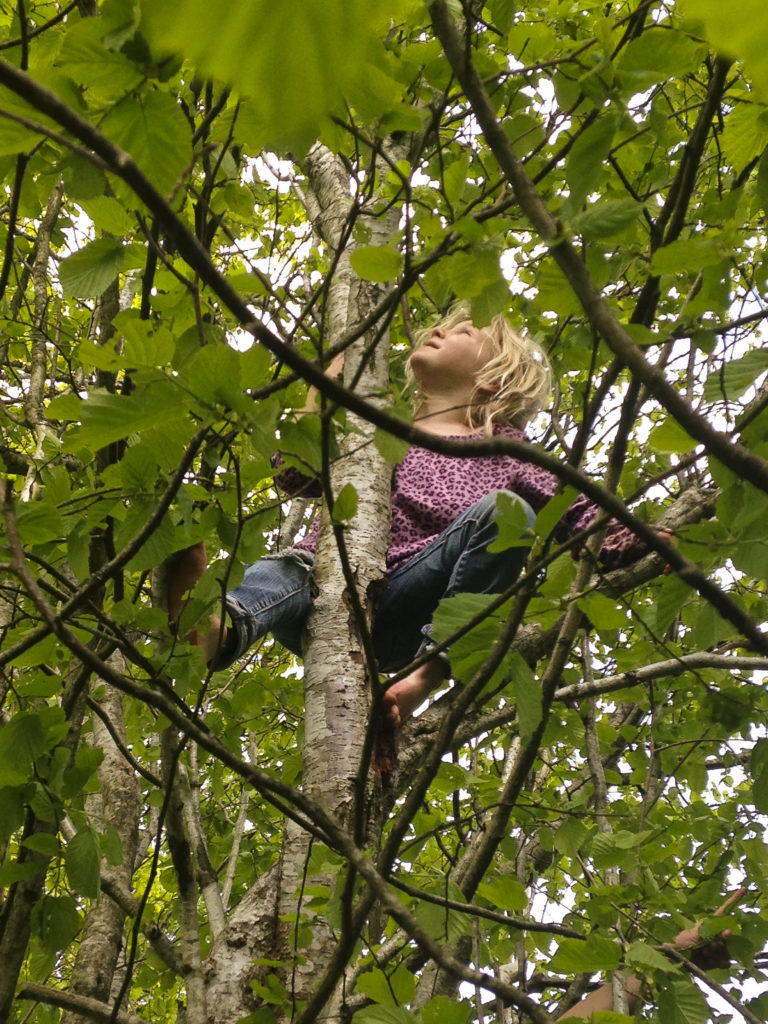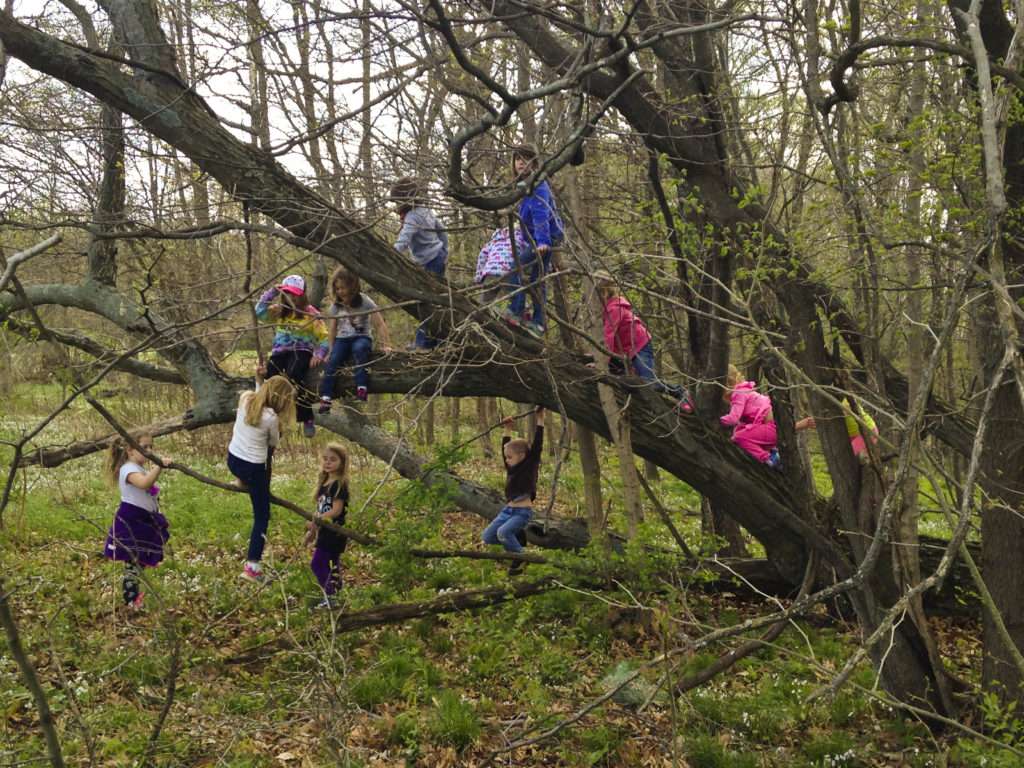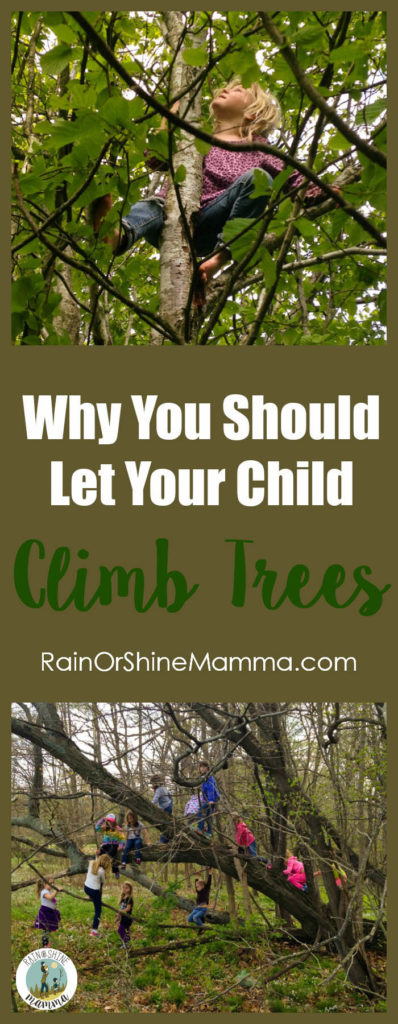As long as I can remember, my girls have climbed trees. Skinny trees, big trees, crooked trees, straight trees, old trees, young trees, pine trees, deciduous trees… They’ve climbed trees in snow suits in the winter and barefoot in the summer. On more than one occasion, they’ve climbed trees wearing princess dresses. And you know what? Sometimes I join them on their tree climbing missions. (Minus the Disney dresses, that is…)
For my generation, tree climbing was a quintessential childhood experience, on a par with running under the sprinkler on a hot summer day and skinning your knees when riding your bike just a tad too fast on a gravel road. But today, it isn’t a given activity for many kids, and for a number of reasons. For one, we all know that they spend more time indoors on electronic devices, which leaves less time to romp around in the woods in the first place. Parents and caregivers also worry more about the safety of tree climbing and many simply don’t allow it. (A study by Play England showed that as many as half of all British children have been stopped from climbing trees.) In some cases, home owners associations or neighbors complain about kids climbing trees because they think it’s a nuisance, and in more than a few places, tree climbing is banned altogether.
And the kids are missing out.

I’m not saying that out of nostalgia. Tree climbing has real benefits for kids – physically, mentally, cognitively and socially. Just think about it. As your child scales the tree he’s building muscle strength, practicing gross motor skills such as balance and improving spatial awareness and proprioception (the awareness of your body’s position and movement, sometimes called the sixth sense). When he decides which branches are safe to stand on and how high to go, he’s learning how to judge risk and developing critical thinking skills. As he plans his path up through the limbs, he’s gaining decision-making and problem-solving skills, and if things don’t go according to plan, he gains emotional strength and resilience by trying again. When he successfully negotiates the branches, he feels a sense of accomplishment, which in turn boosts his self-confidence. Once in the tree, he lets his mind wander and engages in imaginative and creative play – maybe pretending to be a pirate on a ship or a monkey in the jungle. If he’s got friends with him, chances are they’ll join him, nurturing his social skills. As he feels the rugged bark against the palms of his hands and listens to the leaves ruffle in the wind, he connects with nature on a deeper, subconscious level. Most importantly – he’s having fun!
But what if he falls?
Surprisingly little data is available on accidents related to kids climbing trees, but statistics from the U.K. showed that in 2007, children were nearly three times as likely to be admitted to the hospital after falling out of bed than after falling from a tree. In 2016, researchers from University of Phoenix surveyed 1,600 parents who let their children climb trees and found that the most common injury by far was scraped skin. Only 2% of the parents responded that their child had broken a bone and even fewer had suffered from a concussion. Meanwhile, more than 3.5 million American children under the age of 14 receive medical treatment for injuries from organized sports every year.

Besides, what is often forgotten in today’s fear-driven culture is that risky play like tree climbing isn’t just completely normal for kids, it’s absolutely necessary for normal development. Psychologist Peter Gray, who is a thought leader on risky play, goes as far as saying that the decline in children’s play has contributed to a massive increase in mental disorders among young people the past decades.
“The story is both ironic and tragic,” Gray writes. “We deprive children of free, risky play, ostensibly to protect them from danger, but in the process we set them up for mental breakdowns. Children are designed by nature to teach themselves emotional resilience by playing in risky, emotion-inducing ways. In the long run, we endanger them far more by preventing such play than by allowing it.”
I know from experience that allowing risky play can be hard, because we’re wired to protect our progeny. That parental instinct is a good thing, until it turns into irrational fear of things that are actually healthy for our kids. Just like researchers believe being overly clean can cause the immune system to turn on itself and increase the risk of asthma and allergies, keeping kids overly safe can make them less able to manage risk and regulate their emotions.
But let’s face it: even for parents who know the benefits of risky play and embrace it, it can be hard to stay totally cool when your child disappears 15 feet up into a tree. That’s why, as we head out into the woods, we need to remember that it’s our kids’ job to push their boundaries. Sometimes, them climbing a tree can make us feel nervous and uncomfortable, but that doesn’t mean they aren’t safe!

Tree climbing resources:
- In Defense of Tree Climbing and Other Risky Play
- 15 Reasons to Climb a Tree and other Benefits of Risky Play
- Benefits and risks of tree climbing on child development and resiliency



What a wonderful post! Thank you for spreading the word! My parents encouraged me to climb trees and some of my strongest and most powerful connections with nature happened while my legs were swinging from a branch. I encouraged my boys to climb trees and we built a tree fort together.???
Thank you, Diane! I’m glad you had the opportunity to climb trees when you were little, and gave your boys the chance to experience it as well:)
We had a rule in our family that you could climb any tree that you could get into by yourself. No one could lift you into it, but you could go get a chair or step ladder, by yourself, to climb in. The thought was that, if you able to realize that the height needed a ladder, you were able to get into the tree. We had few, if any accidents from the trees. My brother did break his wrist running, and tripping, in the park though.
Those sound like sensible rules to me:) Yes, fractures while playing outside happen but fortunately kids’ bodies heal quickly.
My son actually fell out of a tree. Maybe 8 feet high. Broke his wrist. They casted it and it didn’t heal right. Then it had to be rebroken, this time adding pins. He was 5 and now has an arm with an unnatural curve. So I do not agree with your positive reinforcement about allowing children to participate in dangerous activities. And for the record, this occurred at his mother’s house.
I don’t get your absolute reasoning? That would mean no-one should walk because you can sprain an ankle and never heal right? There’s a million cases of injuries healing bad, mostly due to medical incopetence or lack of proper phisiotherapy afterwards, or simply because you got damned unlucky. How can that extrapolate to deprive your children from living? to die you only need to be alive. Our job is to help them thrive, not turn them into houseplants. Learning and developing yourself has risks, that’s by definition why you grow and better yourself, to overcome difficulties, else why bother?
That’s my rule too! My four kids climb trees. I was an avid tree climber in my day…. but I told my husband do not help them into the trees, if they’re unable to get into it themselves then they aren’t able-bodied enough to stay in or get out of the tree. This rule has done me well as they aren’t developmental or physical ready for that tree yet. Patience, perseverance pays off with the satisfaction of ultimately being able to climb that tree one day. I believe it helps with goal planning later in life.
My dad was a tree man for many years and my boys started climbing early in life…my eldest son now owns his small tree company…his 11 y.o. daughter can now run the equipment, bucket truck, has her own personal saw that fits her and not only climbs freely but has her own saddle and helmet for going really high…she’s been 50′ in a tree…she’s a tiny girl also ..I am proud they are following grandpa’s footsteps…
Wow, that’s amazing! I’m not sure I’d be brave enough to go up 50 feet – actually I know I’m not..!
This is great. And the photos are awesome!
Thank you!
It is good to see that we have finally removed the cotton wool that society has surrounded our children with these days. Fortunately I’m of the era that road push bikes without a helmet and survived other than a few skinned knees.
The skills that they learn from climbing trees will be used throughout their life in all manner of sports and pursuits.
Conversely;- not to allow your children to climb trees is a crime against the future.
Oh I love this. My sisters and I grew up climbing the apricot and peppercorn trees at my grandmother’s house and we loved to see who could get the highest and get to the best spot. I think that’s why I love trees so much now. We had a massive peppermint tree in our yard a few years ago and my daughter used to swing from the long skinny branches like Tarzan lol…… one day a branch gave out on her mid swing and she landed on her bum…. was so funny but she got up grabbed another branch and started all over again……. tree climbing is the best fun…. you’ve inspired me to write a post on tree climbing being as I remember doing it with such love and joy.
I think many of us have special memories related to climbing trees and I think it says a lot about their powerful impact. Thanks for sharing your story; glad you’re feeling inspired!
There is. Nothing more challenging, nor delightful, than climbing trees! I never saw a tree I didn’;t want to climb…and I climmbed most of them! Trees are wonderful places to watch the world around you!?❤️
I agree! I need to do it more often myself.
Best article! We run a girls organization strongergirlstogether.com and one of their favorite activities is when we go climb trees! Risky play junkies! Several of them have never climbed and they are ages 8-12.
I will continue to follow you and shared this article happily to all our readers and parents!
Thank you ??♥️
Lilly
Sounds like a wonderful organization! Thanks for sharing this article:)
I love this article. I went through my pictures after a friend shared this article and I have dozens of pictures of my whole family climbing trees. We have a very favorite climbing tree we visit on vacation up near Traverse City Michigan, near the National Sleeping Bear Dunes Shoreline. There was a huge storm there a few years ago and I was beyond relieved that “our” tree wasn’t damaged. I even took a group of middle school students on a field trip way up there and made sure to stop at “my” tree. You could tell which ones had been encouraged to climb trees and for some, it was their first time or they were completely unwilling to even try. We are so blessed to have nature’s playground in our world and thank you for your article encouraging parents to let their children play on it.
Thank you for sharing your memories; I love that your entire family are tree climbers! I think trees are an essential part of childhood and I’m glad you have a special tree in your life:)
My kids love climbing trees, especially the tall magnolia out front. They even rigged a pulley to bring up their lunch in a bucket and what a view they had! Climbing trees, exploring the creeks, and camping have been such an important part of their childhood fun- and as you note, important to their mental health. . Thanks for the encouragement! Best, Gwen
Thanks for sharing, Gwen! Magnolia trees are often great for climbing and what a fun way to eat your lunch:) Glad your kids get to experience the outdoors.
We’re one of the rare families with a serious tree climbing accident. My son was at Grandma’s & fell out of a tree at age 7 (and he was very small for his age, so about the size of an average 5 year old at the time). He not only had a severe concussion, but also a *skull* fracture. Fortunately he made a full recovery. That said, he still loves to climb trees & we let him. But I will be honest that it does give me anxiety, and I have been known to tell him, “That’s high enough!”
So sorry to hear that:( I totally understand your anxiety; a little bit of caution will hopefully help moderate that. I’m glad you still let him climb!
But why use ‘he’ to refer to the child climbing the trees…why not ‘they’ ??
Hi Coleen – Thanks for writing; I agree that it’s important to be mindful about using gender pronouns. As a non-native English speaker, the pronoun ‘they’ has for some reason never come naturally to me. Since I have two daughters, I tend to use ‘she’ the majority of the time, so I consciously try to insert ‘he’ sometimes to balance things out.
“They” is a plural pronoun, which has come to be used in our politically correct society as a singular pronoun, but I find it silly. I sometimes use “s/he”, but really, life is too short to be concerned about it either way, in my opinion.
explain how to test a branch so they can determine if it will hold their weight, then let them go. I did have to climb a tree when my son got so high he got scared to come down though. Hadn’t climbed a tree in about 30 years but I had a ball reliving my youth while rescuing my son
I’m glad your son’s little mishap gave you a chance to rediscover the joy of tree climbing:)
Thank you, Linda, for this post. I couldn’t agree more. As a 70-year-old man, I prune our apple trees, and it is amazing how much core strength it takes! I feel it now and realize more how climbing trees truly is a great exercise in a purely physical sense. Of course as a child in Colorado, I nearly lived in our trees. My friends and brother built all kinds of forts in the neighborhood trees.
Yes, it takes some strength for sure! I’m working on getting myself up in the trees more often – as an adult it’s easy to forget how much fun it is:)
I read a quote a while ago that basically said if children do not learn to love nature when they are children, they are not going to want to preserve it when they are adults. This can be said for trees. If children don’t learn to love trees when they are young, they are less likely to want to protect and save trees when they are adults. Climbing trees is one great way to develop a love for trees.
Yes, totally agree! That connection to nature in general and trees in particular is so important to foster environmental stewardship – and Mother Earth needs it now more than ever.
Moved to the country so my children could have more outdoor experiences. 3 days after the move my son fell out of a tree and broke both wrists and one elbow. I’ll let you imagine the looks we got while he was in 1 full arm and 1 half arm cast. Before his wounds were healed we built a tree house to encourage climbing to it instead of climbing to the top of the tree. A few months later he fell back off a stool and fractured his shoulder blade. Life lessons, I suppose.
Oh no…! Sounds like he had a really bad streak:( Fortunately, kids’ bones usually heal quickly. Great idea with the tree house!
Yes, I understand how outdoor adventure could link to a child exploring and learning of their capabilities and building confidence. Whether, they are climbing trees, walking a mountain, ghyll scrambling, there’s so many great activities they can do to realise what they can achieve and also, as a family together to help and encourage each other.
I am of an age where my childhood in village life was climbing trees regularly. However, I not sure this truly built resilience for my mental health, I found and still find it difficult to build a resilience to personalities that are cruel natured, Whether this is at a work place, relationship or people easily ‘trolling’ on the internet.
We can not just expect children to climb trees and be able to deal with the emotional bullying they may receive.
Teaching children via school and parenting how to deal with unkindness, and teaching them how to be kind, how to support friends when life isn’t always going to plan would be a better impact, than expecting climbing trees to prevent mental health issues.
Hi Wendy – I don’t think there’s anything that’s 100% effective when it comes to preventing mental illness but spending time in nature has proven benefits and can reduce the risk for it, as can so called risky play. Research professor Peter Gray, who is a big advocate for free, risky play has written a great article about the link between play and mental health that I often share: https://www.psychologytoday.com/intl/blog/freedom-learn/201001/the-decline-play-and-rise-in-childrens-mental-disorders. Having said that, I think teaching children about empathy, both at school and at home, is incredibly important. I’d say both strategies are needed and complement each other, so one doesn’t need to exclude the other.
Thank you so much for this. I saw this when a friend shared the post on social media and I responded in kind.
This is so important for every reason you stated. I don’t have any anecdotes other than my tree-climbing ways in the early 70s. I’m still fit enough to do this, haha. I’ll give my grandkids a run for their money. Since they’re too young to earn real money then that’s a safe bet 😛
One other very very very important aspect is self-preservation. I have always told my kids they need to maintain a weight and physical strength to be able to climb a fence or out of a hole. One never knows when a natural (or man-made) disaster will strike. I’ve been through a few floods and although I’ve never needed to use my climbing skills to survive, I have adequate confidence to know I could if I needed to. No sitting on a roof, squawking for help from me!
That’s a really good point! It never hurts to increase your chances of getting out of a potentially hazardous situation:)
Love your article on tree climbing and its benefits. My fondest memories are those of climbing the many huge fruit trees in my suburban back yard. Most were taller than the roof line, which made it even more exciting as I was able to climb onto the verandah or garage roof to pick the sweetest, ripest fruit from the tops of the tress. Much to my mother’s dismay (rather than cleaning house), I spent many, many days perched in the fork of whichever tree was fruiting (figs, apricots, locquats) with a cushion for my back and my favourite Edin Blyton book ‘The Magic Faraway Tree’, reaching out my hand to pick the juisiest fruit from the tops of the trees.
Now I’m an Early Childhood Teacher and I actively encourage my children to climb the many trees at our centre. The main rule being, they must be able to climb up and get down by themselves. (No lifting into the trees). Of course I will support them to problem solve if they find they have climbed too high and need some critical thinking strategies to help them get down again.
Those are some really nice memories! I can’t think of a better place to enjoy a good book than in the fork of a tree:)
I struggle continually parenting my now six year old. I relate and celebrate everything you say here and I let him play rough, but I worry about him damaging nature. I want to teach leave no trace. I don’t want him climbing small trees and breaking their branches off. He broke a major branch of a young apple tree last summer and although he was hurt a little I didn’t worry about him, but about the tree. And about his developing respect for nature. The same thing happens when were in the forest and he ways to explore of path. I want him to explore and feel comfortable being adventurous, but I also want him to respect that paths are there to protect nature around then. Do you have any thoughts about this?
I think the best you can do is to try to strike a balance. Definitely keep talking to him about not damaging nature “do not disturb, do not destroy” but it’s inevitable that kids’ actions sometimes will be destructive. My first strategy would be to redirect his energy into something that is a little less destructive, for example whittling sticks that are already on the ground instead of breaking branches off trees, climbing bigger trees instead of smaller ones etc. I wouldn’t worry too much, though. I’m sure the respect for nature will come as he matures and as you keep guiding him. The damage done to nature by a six-year-old is still comparatively small and something that nature can usually easily recover from. I’d say the damage from keeping him away from nature would be much greater in the long run:)
I love your matter of fact attitude: let kids be kids. Growing up my greatest memories are in trees.
I came upon your site because I was trying to tell how much climbing and what kind of climbing are age appropriate. My little climber is 3 1/2. He’s been climbing for at least 2 yrs according to pictures. (Although it sometimes seems like he’s been climbing for like 4 years.)
Lately, he’s hanging from the branches and is starting to let go. ???? I was not expecting that from a 3 yr old.
Any thoughts? (Besides the obvious safety concerns. LOL)
Sounds like your little one is keeping you busy:) I think the hanging from tree branches is a natural development from the climbing phase, swinging back and forth stimulates a child’s vestibular sense, which is crucial for a healthy development. If he’s high enough in the tree that you’re worried about him getting injured when he lets go, you can always spot him from the ground. Otherwise, I’d stay back and let him do his thing as much as possible.